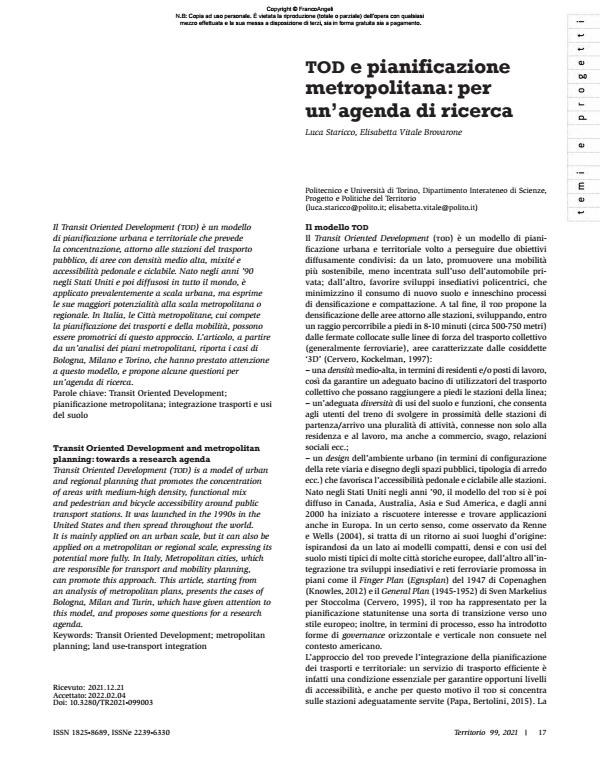Tod e pianificazione metropolitana: per un’agenda di ricerca
Titolo Rivista TERRITORIO
Autori/Curatori Luca Staricco, Elisabetta Vitale Brovarone
Anno di pubblicazione 2022 Fascicolo 2021/99
Lingua Italiano Numero pagine 8 P. 17-24 Dimensione file 380 KB
DOI 10.3280/TR2021-099003
Il DOI è il codice a barre della proprietà intellettuale: per saperne di più
clicca qui
Qui sotto puoi vedere in anteprima la prima pagina di questo articolo.
Se questo articolo ti interessa, lo puoi acquistare (e scaricare in formato pdf) seguendo le facili indicazioni per acquistare il download credit. Acquista Download Credits per scaricare questo Articolo in formato PDF

FrancoAngeli è membro della Publishers International Linking Association, Inc (PILA)associazione indipendente e non profit per facilitare (attraverso i servizi tecnologici implementati da CrossRef.org) l’accesso degli studiosi ai contenuti digitali nelle pubblicazioni professionali e scientifiche
Il Transit Oriented Development (tod) è un modello di pianificazione urbana e territoriale che prevede la concentrazione, attorno alle stazioni del trasporto pubblico, di aree con densità medio alta, mixité e accessibilità pedonale e ciclabile. Nato negli anni ’90 negli Stati Uniti e poi diffusosi in tutto il mondo, è applicato prevalentemente a scala urbana, ma esprime le sue maggiori potenzialità alla scala metropolitana o regionale. In Italia, le Città metropolitane, cui compete la pianificazione dei trasporti e della mobilità, possono essere promotrici di questo approccio. L’articolo, a partire da un’analisi dei piani metropolitani, riporta i casi di Bologna, Milano e Torino, che hanno prestato attenzione a questo modello, e propone alcune questioni per un’agenda di ricerca.
Parole chiave:Transit Oriented Development; pianificazione metropolitana; integrazione trasporti e usi del suolo
- Innovation in Urban and Regional Planning Alessia Guaiani, pp.705 (ISBN:978-3-031-54117-9)
- Metropolitan governance in Europe: a classification of current national models Donato Casavola, Giancarlo Cotella, Umberto Janin Rivolin, Elisabetta Vitale Brovarone, in disP - The Planning Review /2025 pp.62
DOI: 10.1080/02513625.2025.2561514
Luca Staricco, Elisabetta Vitale Brovarone, Tod e pianificazione metropolitana: per un’agenda di ricerca in "TERRITORIO" 99/2021, pp 17-24, DOI: 10.3280/TR2021-099003